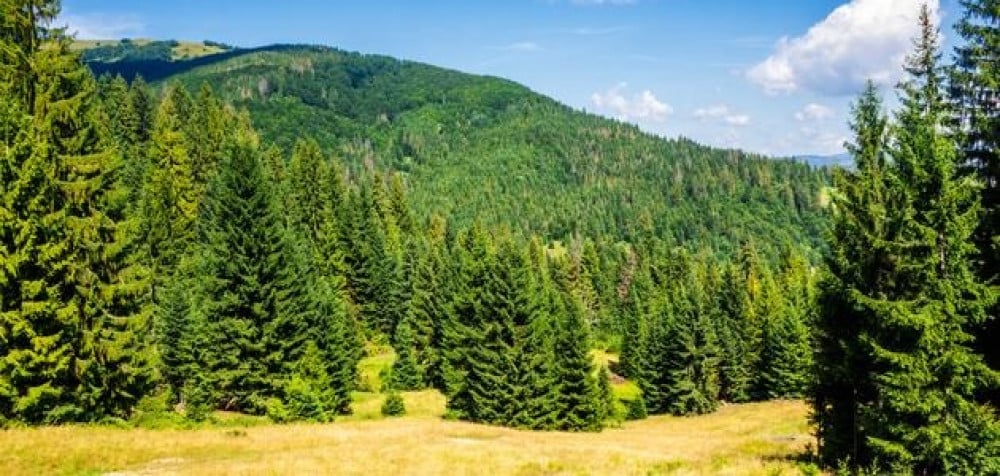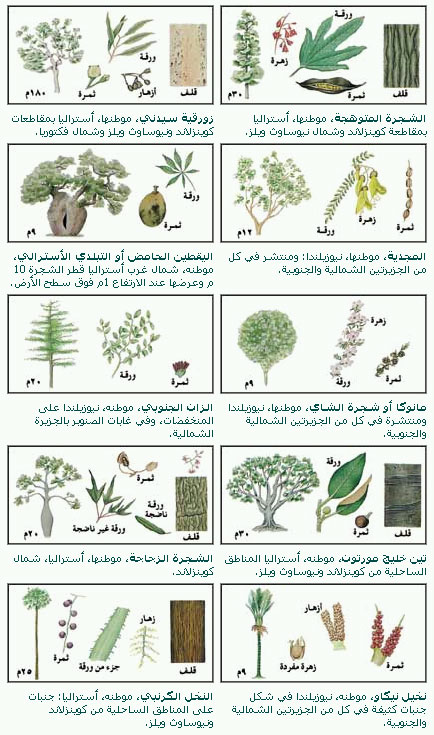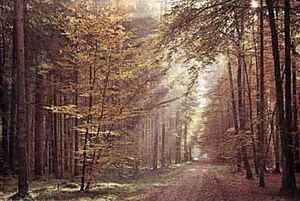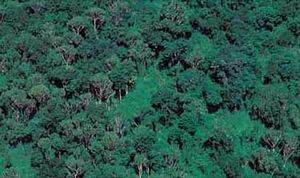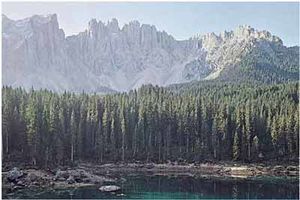trees around the world
Trees of Australia and New Zealand
In some parts of the world trees grow in dense forests, and in some areas they don't grow at all. Trees need to grow for a period of more than two frost-free months each year. The few trees that grow in the Arctic do not reach the full size of a tree. No trees can grow in the snow and extreme cold of Antarctica. Most trees also need 40 to 50 cm of rain per year. There are only a few trees such as the Joshua tree and some types of palm trees that remain alive in the deserts.
Most broadleaf trees grow bushy in warm, moist areas for at least three or four months of the year. The cooler and drier areas are considered the most suitable areas for the growth of most trees with needle leaves, but some trees with broad leaves, such as types of rods, and willows grow well in cold regions, and some trees with needle leaves, such as yewsodium and various types of pine, need a climate a bit warm. Palm trees also grow in warm regions around the world, especially the wet and dry tropics. Pansies, cycads, and tree ferns often grow in the humid tropics and other warm, humid regions. Tulip trees also thrive in warm regions, but they don't need as much moisture as pansies, cycads, and tree ferns.
Most different tree species also need different types of soil. Many needle-leaved trees grow well in poor, sandy soils. While most broadleaf trees need more fertile soil.
Some trees grow singly or in small groups. In areas with little moisture, trees may grow only on the banks of rivers, and tree seeds carried by sea currents may grow on coasts. People also plant individual trees in places such as parks and gardens, but the vast majority of trees grow in forests, with the world's forest regions mostly made up of broadleaf and needle-leaved trees.
Broadleaf forests
Broadleaf forests or hardwood forests grow in many parts of the world. In temperate regions, most broadleaf trees lose their leaves each fall.
These forests grow in areas that have a long growing season and abundant rainfall. All continents contain broadleaf forests except Antarctica. These forests are also called hardwood forests. In areas with cold, snowy winters, most of the trees that make up broadleaf forests lose their leaves each fall. In the tropics, most of its trees are evergreen broad leaves.
Broad-leaved forests once covered large areas of the northern hemisphere. It included trees such as birch, birch, beech, and oak species. Over time, most of these forests were cut down to provide wood and fuel and to make room for agriculture and cities. At present, broadleaf forests are found in limited areas.
Broadleaf forests, mostly false aspen and balsam, cover large areas in southern Siberia and parts of southern Canada. Forests of birch and oak species also grow in eastern Europe and along the Yellow Sea coast of China and Korea. In Australia, both eucalyptus and acacia trees dominate the landscape. Eucalyptus trees are among the highest trees in the world. As some of them reach a height of more than 90 m.
In many areas, mixed forests of broadleaf and needle-leaved trees grow near broadleaf or needle-leaved forests. This type of forest is found in large areas in central and southern Europe, central Canada, eastern United States, and eastern Asia.
tropical rain forests
Tropical rainforests grow in Uganda and other hot and humid regions. Most broadleaf trees are evergreen, and despite the similarity of the trees, they belong to several different species.
Fantastic broadleaf forests grow in tropical regions with a perpetually hot climate and regular rainfall throughout all months of the year. Many of the trees in these tropical forests are similar, and they are tall trees, many of which reach a height of more than 45 meters, with dark green leathery leaves. Most of the trees are evergreen, because they receive rain throughout the year, so the trees may be similar, but they belong to many types. Many types of palms grow among the broad-leaved trees of tropical forests.
The largest tropical forests are found in South America, Central America, Central Africa, and Southeast Asia. Tropical forests in many countries in these areas are subject to annihilation in order to meet the world's requirements of timber, and to prepare the land for agriculture and construction. At the end of the eighties of the twentieth century, tropical forests covered an area estimated at approximately 10,000,000 square kilometers, of which approximately 100,000 square kilometers were wiped out every year. Commercial logging—that is, cutting down trees for timber—causes great ecological damage. Logging of larger trees also destroys smaller trees—and heavy machinery cuts down the remaining vegetation.
Tropical trees were felled to provide alternatives to valuable temperate woods such as beech, oak, and hickory. Tropical hardwoods also have structural and cosmetic properties that are available in temperate trees.
The timber trade deals with a few species of tropical trees. In the Amazon jungle, for example, only 50 species (out of several thousand species) are used. In Africa, only 10% of the available species provide 70% of the total timber exports. As for Southeast Asia, its timber exports focus on 12 species of trees. Gabon, a West African country, relies 90% of its exports on one type of tree, the okoume.
The logging of hardwood trees threatens the extinction of some species. Species at risk include familiar, valuable tropical hardwoods such as teak, teak substitutes, beech substitutes, mahogany, and other tropical redwoods.
Teak is considered one of the best known and most valuable tropical trees. With strength and durability equal to that of oak, it can be shaped easily and has been used over the centuries to build ships and boats. Teak is increasingly scarce these days, in its natural habitat, which is the monsoon forests of Southeast Asia, but it is now grown on commercial farms.
The scarcity of teak and its high prices led to the use of other woods with similar properties to teak, and it is considered the first alternative to Afroromozian teak, which grows in West and Central Africa. After 40 years of its export, this valuable tree is threatened with extinction. Afroromasia is a slow-growing species, in contrast to teak.
The soft-veined, heavy-wood Iroko has been sold on the international market for many years under the name West African Teak, and is now a rare variety. At current cutting rates, the iroko tree is expected to be extinct by the end of the twentieth century.
Another type of decorative wood, Borneo teak is a dark reddish-brown wood used in furniture, window frames, and parquet floors. Most of Borneo's natural tek forests have been depleted, except for those found in Indonesia and Papua New Guinea.
Timber merchants turned to the tropics in search of alternatives to European beech. This has caused the decline in populations of common species such as the West African obiki and Indonesian ramen. Nigeria has banned the export of Obeki in 1975.
One of the original gifts of the New World is Cuban mahogany, or small-leaf mahogany. It was known as a good type of wood by the conquistadors, and the huge ships of the Spanish fleet were built from this durable, narrow-veined wood. Different growth conditions cause different colors in the wood, but almost all mahogany tends to be dark reddish-brown with a yellow luster. In addition to its beauty, mahogany is easy to form and prepare, and it resists cracking and warping after its formation and preparation.
All types of mahogany are now under threat of extinction; All the small-leaf mahogany, which grows in an almost natural state, has been exterminated. The Government of Brazil employed armed guards to prevent the removal of blocks of mahogany from the Indians' territories.
Wood dealers tend to call many red tropical hardwoods mahogany, even though they are not true mahogany, and are generally more fragile than true mahogany. Diptrocarp species, which account for the majority of Southeast Asian exports, have several local names. The same or similar woods may be called Philippine mahogany or loan in the Philippines, while saraya in Indonesia and maranti in western Malaysia.
There is a type of wood, similar to mahogany, found in West Africa. It is called khaya or red mahogany. It has been sold in Europe since the middle of the nineteenth century, and the descriptions of this wood are similar to those of real mahogany, and therefore it is in great demand. Ghana has halted the export of five species of wood to prevent their extinction, while the akaju, Côte d'Ivoire's main export, remains endangered.
Conservation of tropical rainforests
There are no effective measures to reduce the cutting of endangered tree species, and one of the main problems in this regard is the lack of statistics on the effects of tree cutting and handling on different types of wood.
During the eighties of the twentieth century AD, some wood-producing countries took steps to secure their natural heritage. Nigeria, Ghana, the Philippines, Malaysia and Indonesia applied measures to limit the export of wood. In 1988, Thailand imposed an immediate ban on cutting and trading trees. The long-term goals of conservationists include the rational management of forests and the establishment of plantations of tropical trees, and these two goals have been in the eyes of those interested in preserving the environment. This was clearly demonstrated in the Global Tropical Timber Treaty, which became effective in April 1985.
Needle-leaved forests
Needle-leaf forests, or softwood forests, cover large areas in the far north as well as the slopes of some mountain ranges such as the Italian Alps (above).
These forests often grow in areas with long, cold winters. These forests, which are also called softwood forests, extend across northern Europe, Siberia and Canada. Many species of fir, larch, and spruce grow in these boreal forests, together with a few broadleaf trees such as birch and willow. Some species of willow also grow north of the needle-leaved trees, but they do not exceed the size of shrubs. Needle-leaf forests also cover the slopes of mountain ranges such as the Alps and the Rocky Mountains.
A few needle-leaved forests grow in warmer regions. For example, large areas of pine forests cover the southeastern United States. These forests provide large amounts of wood suitable for the production of lumber and pulp.

